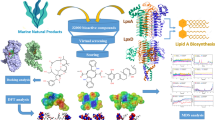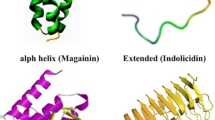Abstract
Latarcins are linear, α-helical antimicrobial peptides purified from the venom of the Central Asian spider Lachesana tarabaevi, with lytic activity against Gram-positive and Gram-negative bacteria, erythrocytes, and yeast at micromolar concentrations. In this work, we investigated the role of the hinge in latarcin 2a (ltc2a, GLFGKLIKKFGRKAISYAVKKARGKH-COOH), which adopts a helix–hinge–helix conformation in membrane-mimicking environments, on peptide–membrane interactions and its potential effect on the selective toxicity of the peptide. A modified latarcin 2a, ltc2aG11A, obtained by replacing the glycine at position 11 with alanine (ltc2aG11A, GLFGKLIKKFARKAISYAVKKARGKH-COOH), adopts a more rigid structure due to the reduced conformational flexibility. Langmuir monolayer measurements combined with atomic force microscopy and X-ray photoemission electron microscopy (X-PEEM) indicate that both peptides bind and insert preferentially into anionic compared with zwitterionic phospholipid monolayers. Modified ltc2aG11A was found to be more disruptive of supported phospholipid bilayer modeling mammalian cell membrane. However, no considerable difference in lytic activity of the two peptides toward bacterial membrane was found. Overall the data indicate that decrease in the flexibility of ltc2a induced by the modification in the hinge region is likely to increase the peptide’s nonspecific interactions with zwitterionic cell membranes and potentially increase its toxicity against eukaryotic cells.








Similar content being viewed by others
References
Ambroggio EE, Separovic F, Bowie J, Fidelio GD (2004) Structure behaviour and peptide-lipid interactions of the antibiotic peptides, maculatin and citropin. Biochim Biophy Acta 1664:31–37
Brockman H (1999) Lipid monolayer: why use half a membrane to characterize protein-membrane interactions? Curr Opin Struct Biol 9:438–443
Brogden KA (2005) Antimicrobial peptides: pore formers or metabolic inhibitors in bacteria? Nature Rev Microbiology 3:238–250
Chakrabartty A, Baldwin JA, Baldwin RL (1991) Large differences in the helix propensities of alanine and glycine. Nature 351:586–588
Constantino CJL, Dhanabalan A, Oliveira ON (1999) Experimental artifacts in the surface pressure measurement for lignin monolayers in langmuir troughs. Rev Sci Instrum 70:3674–3680
Domenech O, Francius G, Tulkens PM, Van Bambeke F, Dufrene Y, Mingeot-Leclercq MP (2009) Interactions of oritavancin, a new lipoglycopeptide derived from vancomycin, with phospholipid bilayers: effect on membrane permeability and nanoscale lipid membrane organization. Biochim Biophys Acta Biomembr 1788:1832–1840
Dubovskii PV, Volynsky PE, Polyansky AA, Chupin VV, Efremov RG, Arseniev AS (2006) Spatial structure and activity mechanism of a novel spider antimicrobial peptide. Biochemistry 45:10759–10767
Dubovskii PV, Volynsky PE, Polyansky AA, Karpunin DV, Chupin VV, Efremov RG, Arseniev AS (2008) Three-dimensional structure/hydrophobicity of latarcins specifies their mode of membrane activity. Biochemistry 47:3525–3533
Eisenberg D, Weiss RM, Terwilliger TC, Wilcox W (1982) Hydrophobic moments and protein structure. Faraday Symp Chem Soc 17:109–120
Epand RF, Savage PB, Epand RM (2007) Bacterial lipid composition and the antimicrobial efficacy of cationic steroid compounds (Ceragenins). Biochim Biophys Acta 1768:2500–2509
Gidalevitz D, Ishitsuka Y, Muresanv AS, Konovalov O, Waring AJ, Lehrer RI, Lee KYC (2003) Interaction of antimicrobial peptide protegrin with biomembranes. Proc Natl Acad Sci 100:6302–6307
Guani-Guerra E, Santos-Mendoza T, Lugo-Reyes SO, Teran LM (2010) Antimicrobial peptides: general overview and clinical implications in human health and disease. Clin Immunol 135:1–11
Hancock REW, Sahl H-G (2006) Antimicrobial and host-defense peptides as new anti-infective therapeutic strategies. Nature Biotech 24:1551–1557
Ibrahim HR, Thomas U, Pellegrini A (2001) A helix-loop-helix peptide at the upper lip of the active site cleft of lysozyme confers potent antimicrobial activity with membrane permeabilization action. J Biol Chem 276:43767–43774
Ira P, Johnston LJ (2008) Spingomyelinase generation of ceramide promotes clustering of nanoscale domains in supported bilayer membranes. Biochim Biophys Acta 1778:185–197
Javadpour MM, Eilers M, Groesbeek M, Smith SO (1999) Helix packing in polytopic membrane proteins: role of glycine in transmembrane helix association. Biophys J 77:1609–1618
Kim K, Kim C, Byun Y (2001) Preparation of a dipalmitoylphosphatidylcholine/cholestrol langmuir-blodgett monolayer that suppresses protein adsorption. Langmuir 17:5066–5070
Koprinarov IN, Hitchcock AP, McCrory CT, Childs RF (2002) Quantitative mapping of structured polymeric systems using singular value decomposition analysis of soft X-ray images. J Phys Chem B 106:5358–5364
Kozlov SA, Vassilevski AA, Feofanov AV, Surovoy AY, Karpunin DV, Grishin EV (2006) Latarcins, antimicrobial and cytolytic peptides from the venom of the spider Lachesana tarabaevi (Zodariidae) that exemplify biomolecular diversity. J Biol Chem 281:20983–20992
Lee S-A, Kim YK, Lim SS, Zhu WL, Ko W, Shin SY, Hahm K-S, Kim Y (2007) Solution structure and cell selectivity of piscidin 1 and its analogues. Biochemistry 46:3653–3663
Leung BO, Hitchcock AP, Cornelius R, Brash JL, Scholl A, Doran A (2009) An X-ray spectromicroscopy study of protein adsorption to a polystyrene-polylactide blend. Biomacromolecules 10:1838–1845
Li S-C, Deber CM (1994) A measure of helical propensity for amino acids in membrane environments. Nat Struct Mol Biol 1:368–373
Liu ZH, Qian W, Li J, Zhang Y, Liang S (2009) Biochemical and pharmacological study of venom of the wolf spider Lycosa singoriensis. J Venom Anim Toxins incl Trop Dis 15:79–92
Maget-Dana R (1999) The monolayer technique: a potent tool for studying the interfacial properties of antimicrobial and membrane-lytic peptides and their interactions with lipid membrane. Biochim Biophys Acta 1462:109–140
Majerowicz M, Waring AJ, Wen S, Bringezu F (2007) Interaction of the antimicrobial peptide dicynthaurin with membrane phospholipids at the air-liquid interface. J Phys Chem B 111:3813–3821
Mansour H, Wang D, Chen C, Zografi G (2001) Comparison of bilayer and monolayer properties of phospholipid systems containing dipalmitoylphosphatidylglycerol and dipalmitoylphosphatidylinositol. Langmuir 17:6622–6632
Melo MN, Ferre R, Castanho M (2009) Antimicrobial peptides: linking partition, activity and high membrane-bound concentrations. Nat Rev Microbiol 7:245–250
Minones J Jr, Dynarowicz-Latka P, Minones J, Rodrigez Patino JM, Iribarnegaray EJ (2003) Orientational changes in dipalmitoyl phosphatidyl glycerol langmuir monolayers. J Colloid Interface Sci 265:380–385
Nakahara H, Lee S, Sugihara G, Shibata O (2006) Mode of interaction hydrophobic amphiphilic α-helical peptide/dipalmitoylphosphatidylcholine with phosphatidyglycerol or palmitic acid at the air-water interface. Langmuir 22:5792–5803
Nakorn PN, Meyer MC, Flach CR, Mendelson R, Galla H-J (2007) Surfactant protein C and lung function: new insights into the role of ·-helical length and palmitoylation. Eur Biophys J 36:477–489
Oh D, Shin SY, Lee S, Kang JH, Kim SD, Ryu PD, Hahm K, Kim Y (2000) Role of the hinge region and the tryptophan residue in the synthetic antimicrobial peptides, cecropin A(1-8)-magainin 2(1-12) and its analogues, on their antibiotic activities and structures. Biochemistry 39:11855–11864
Ohe C, Ida Y, Matsumoto S, Sasaki T, Goto Y, Noi M, Tsurumaru T, Itoh K (2004) Investigations of polymyxin B-phospholipid interactions by vibrational sum frequency generation spectroscopy. J Phys Chem B 108:18081–18087
Oishi Y, Takashima Y, Suehiro K, Kajiyama T (1997) Effect of ionic repulsion among hydrophilic groups on aggregation structure of fatty acid monolayer on the water surface. Langmuir 13:2527–2532
Okamoto Y, Hansmann UHE (1995) Thermodynamics of helix-coil transitions studied by multicanonical algorithms. J Phys Chem 99:11276–11287
Pascholati CP, Lopera EP, Pavinatto FJ, Caseli L, Nobre TM, Zaniquelli MED, Viitala T, D’Silva C, Oliveira ON Jr (2009) The interaction of an antiparasitic peptide active against African sleeping sickness with cell membrane. Colloids Surf B Biointerfaces 74:504–510
Polyansky AA, Vassilevski AA, Volynsky PE, Vorontsova OV, Samsonova OV, Egorova NS, Krylov NA, Feofanov AV, Arseniev AS, Grishin EV, Efremov RG (2009) N-terminal amphipathic helix as a trigger of hemolytic activity in antimicrobial peptides: a case study in Latarcins. FEBS Lett 583:2425–2428
Pukala TL, Brinkworth CS, Carver JA, Bowie JH (2004) Investigating the importance of the flexible hinge in caerin 1.1: solution structures and activity of two synthetically modified caerin peptides. Biochemistry 43:937–944
Pukala TL, Boland MP, Gehman JD, Kuhn-Nentwig L, Separovic F, Bowie JH (2007) Solution structure and interaction of cupiennin 1a, a spider venom peptide, with phospholipid bilayers. Biochemistry 46:3576–3585
Reddy KV, Yedery RD, Aranha C (2004) Antimicrobial peptides: premises and promises. Int J Antimicrob Agents 24:536–547
Rohl CA, Fiori W, Baldwin RL (1999) Alanine is helix-stabilizing in both template-nucleated and standard peptide helices. Proc Natl Acad Sci USA 96:3682–3687
Shaw JE, Alattia J-R, Verity JE, Prive GG, Yip CM (2006) Mechanisms of antimicrobial peptide action: studies of indolicidin assembly at model membrane interfaces by in situ atomic force microscopy. J Struct Biol 154:42–58
Shaw JE, Epand RF, Hsu JCY, Mo GCH, Epand RM, Yip CM (2008) Cationic peptide-induced remodeling of model membranes: direct visualization by in situ atomic force microscopy. J Struct Biol 162:121–138
Shlyapnikov YM, Andreev YA, Kozlov SA, Vassilevski AA, Grishin EB (2008) Bacterial production of latarcin 2a, a potent antimicrobial peptide from spider venom. Prot Exp Pur 60:89–95
Stewart-Ornstein J, Hitchcock AP, Hernàndez-Cruz D, Henklein P, Overhage J, Hilpert K, Hale J, Hancock REW (2007) Using intrinsic X-ray absorption spectral differences to identify and map peptides and proteins. J Phys Chem B 111:7691–7699
Van Khan EJM, van der Bent AR, Demel R, de Kruijff B (2001) Membrane activity of the peptide antibiotic clavanin and the importance of its glycine residues. Biochemistry 40:6398–6405
Vollhardt D, Fainerman VB, Siegel S (2000) Interfacial rate processes in adhesion and friction. J Phys Chem B 104:4115–4121
Wang J, Li L, Morin C, Hitchcock AP, Doran A, Scholl A (2009) Radiation damage in soft X-ray microscopy. J Electron Spectrosc Relat Phenom 170:25–36
Won A, Ianoul A (2009) Interactions of antimicrobial peptide from C-terminus of myotoxin II with phospholipid mono- and bilayers. Biochim Biophys Acta 1788:2277–2283
Yeaman MR, Yount NY (2003) Mechanisms of antimicrobial peptide action and resistance. Pharm Rev 5:27–55
Zasloff M (2002) Antimicrobial peptides of multicellular organisms. Nature 415:389–395
Zhang L, Falla TJ (2010) Potential therapeutic application of host defense peptides. Methods Mol Biol 618:303–327
Acknowledgments
Financial support was provided by ERA, NSERC, and CFI. X-ray microscopy was carried out using the polymer STXM on beamline 5.3.2 and the magnetic X-PEEM on beamline 7.3.1 at the ALS, which is supported by the US DoE under contract DE-AC03-76SF00098. We thank David Kilcoyne and Tolek Tyliszczak (STXM532) as well as Andreas Scholl and Andrew Doran (PEEM2) for their diligence and expertise in keeping the beamlines in top condition.
Author information
Authors and Affiliations
Corresponding author
Rights and permissions
About this article
Cite this article
Idiong, G., Won, A., Ruscito, A. et al. Investigating the effect of a single glycine to alanine substitution on interactions of antimicrobial peptide latarcin 2a with a lipid membrane. Eur Biophys J 40, 1087–1100 (2011). https://doi.org/10.1007/s00249-011-0726-z
Received:
Revised:
Accepted:
Published:
Issue Date:
DOI: https://doi.org/10.1007/s00249-011-0726-z




